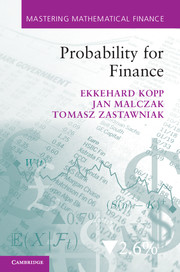4 - Conditional expectation
Published online by Cambridge University Press: 05 June 2014
Summary
We turn our attention to the concept of conditioning, which involves adjusting our expectations in the light of the knowledge we have gained of certain events or random variables. Building on the notion of the conditional probability defined in (3.11), we describe how knowledge of one random variable Y may cause us to review how likely the various outcomes of another random variable X are going to be. We adjust the probabilities for the values of X in the light of the information provided by the values of Y, by focusing on those scenarios for which these values of Y have occurred. This becomes especially important when we have a sequence, or even a continuous-parameter family, of random variables, and we consider how knowledge of the earlier terms will affect the later ones. We first illustrate these ideas in the simplest multi-step financial market model, since our main applications come from finance.
Binomial stock prices
Consider the binomial model of stock prices in order to illustrate the probabilistic ideas we will develop. This model, studied in detail in [DMFM], combines simplicity with flexibility. The general multi-step binomial model consists of repetitions of the single-step model.
- Type
- Chapter
- Information
- Probability for Finance , pp. 106 - 146Publisher: Cambridge University PressPrint publication year: 2013



